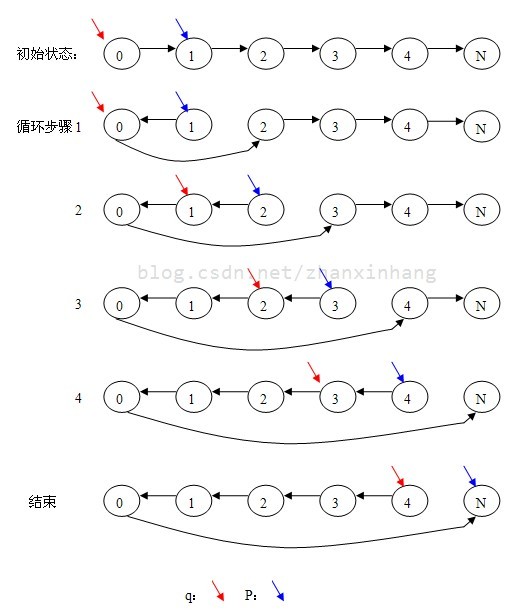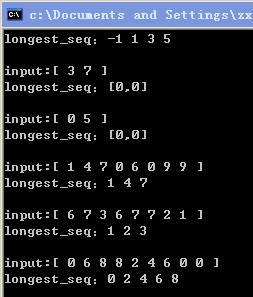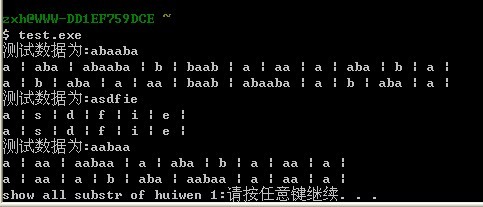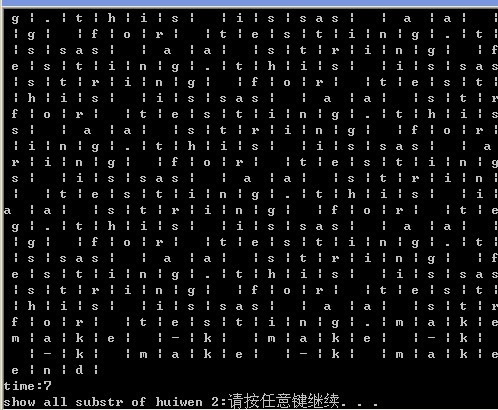每日微軟面試題——day 1
<以下微軟面試題全來自網絡>
<以下答案與分析純屬個人觀點,不足之處,還望不吝指出^_^>
題:.編寫反轉字符串的程序,要求優化速度、優化空間。
分析:構建兩個迭代器p 和 q ,在一次遍歷中,p的位置從字串開頭向中間前進,q從字串末尾向中間后退,反轉字串只要每次遍歷都交換p和q所指向的內容即可,直到p和q在中間相遇,這時循環次數剛好等于 字串的長度/2。
實現代碼:
- /**?
- author:?花心龜?
- blog:http://blog.csdn.net/zhanxinhang?
- **/??
- ??
- #include?<stdio.h>??
- void?reverse(char?*_str,int?_l)?//反轉函數,_l指要反轉字串的長度??
- {??
- ?char?*p=_str,*q=_str+_l-1,temp;??
- ??
- ?while(q>p)??
- ???{???
- ?????temp=*p;??
- ?????*p=*q;??
- ?????*q=temp;??
- ???
- ?????p++;??
- ?????q--;??
- ???}??
- }??
- ???
- int?main()??
- {??
- ??charstr0[11]=?"0123456789";???????
- ?reverse(str0,sizeof(str0)-1);??
- ?printf("str0?=?%s\n",str0);??
- ???
- ??char?str1[6]="01234";??
- ?reverse(str1,sizeof(str1)-1);??
- ?printf("str1?=?%s",str1);??
- ??return?0;??
- }??
題:.在鏈表里如何發現循環鏈接?
分析:可以構建兩個迭代器p和pp,p一次向移動一個節點,pp一次移動兩個節點,如果p和pp在某個時刻指向了同一個節點,那么該鏈表就有循環鏈接。
實現代碼:
- /**?
- Author:花心龜?
- Blog:http://blog.csdn.net/zhanxinhang?
- **/??
- #include?<stdio.h>??
- #include?<malloc.h>??
- ??
- #define?TEST??
- ??
- struct?list_node??
- {??
- ??int?data;??
- ??list_node?*?next;??
- };??
- list_node?*head;?//指向頭結點??
- ??
- void?list_create()??
- {??
- ??int?i;??
- ??list_node?*p=NULL;??
- ??head?=?(list_node*)malloc(sizeof(list_node));??
- ??head->data=0;?????//頭結點數據設為??
- ??head->next?=?NULL;??
- ??
- ??p=head;??
- ??for(i=1;?i<6;?i++)?//創建個結點??
- ????{??
- ??????p->next?=?(list_node*)malloc(sizeof(list_node));??
- ??????p->next->data?=?i;??
- ??????p->next->next?=?NULL;??
- ??????p=p->next;??
- ????}??
- ??p->next?=?head;??//使尾結點的下一個結點指針指向頭結點,構成循環鏈表??
- ??
- #ifdef?TEST??
- ??p=head;??
- ??for(i=0;?i<12&&p!=NULL;?i++)??
- ????{??
- ??????printf("%d?",p->data);??
- ??????p=p->next;??
- ????}??
- ??printf("\n");??
- #endif??
- }??
- ??
- void?cycleList_test()??
- {??
- ??if(head==NULL?||?head->next?==?NULL)??
- ??????return;??
- ??list_node?*p=NULL,*pp=NULL;??
- ??p=head;??
- ??pp=head->next->next;??
- ??while(p!=pp?)??
- ????{??
- ??????p=p->next;??
- ??????pp=pp->next->next;??
- ??
- ??????if(p==NULL?||?pp==NULL)??
- ????{??
- ??????printf("不是循環鏈表");??
- ??????return?;??
- ????}??
- ????}??
- ??printf("是循環鏈表");??
- }??
- ??
- void?list_destroy()??
- {??
- ??list_node?*pmove=NULL,*pdel=NULL;??
- ??pmove=head->next;??
- ??
- ?while(pmove!=head)??
- ???{??
- ?????pdel=pmove;??
- ?????pmove=pmove->next;??
- ?????free(pdel);?????
- ???}??
- ??
- ??free(head);??
- }??
- int?main()??
- {??
- ??list_create();???//構建循環鏈表??
- ??cycleList_test();//測試是否是循環鏈表??
- ??list_destroy();??//銷毀鏈表??
- ??return?0;??
- }?
題:.給出洗牌的一個算法,并將洗好的牌存儲在一個整形數組里。
分析:首先54張牌分別用0到53 的數值表示并存儲在一個整形數組里,數組下標代表紙牌所在的位置。接下來,遍歷整個數組,在遍歷過程中隨機產生一個隨機數,并以該隨機數為下標的數組元素與當前遍歷到的數組元素進行對換。時間復雜度為O(n) (注:所得到的每一種結果的概率的分母越大越好)
實現代碼:
- /**?
- Author:花心龜?
- Blog:http://blog.csdn.net/zhanxinhang?
- **/??
- ??
- #include?<stdio.h>??
- #include?<time.h>??
- #include?<stdlib.h>??
- ??
- void?shuffle(int?boke[])??//洗牌??
- {??
- ??int?i,r,t;??
- ??srand((unsigned)time(NULL));?//隨機數種子??
- ??for(i=0;?i<54;?i++)??
- ????{??
- ??????r=(rand()%107)/2;??
- ??
- ??????//交換??
- ??????t=boke[i];??
- ??????boke[i]=boke[r];??
- ??????boke[r]=t;??
- ????}??
- }??
- ??
- int?main()??
- {??
- ??int?boke[54],i;??
- ??for(i=0;i<54;i++)?//初始化紙牌??
- ????boke[i]=i;??
- ??
- ??printf("before?shuffle:\n");??
- ??for(i=0;?i<54;?i++)????//打印??
- ??????printf("%d?",boke[i]);??
- ??
- ??
- ??shuffle(boke);?????//洗牌??
- ??
- ??
- ??printf("\nafter?shuffle:\n");??
- ??for(i=0;?i<54;?i++)???//打印??
- ??????printf("%d?",boke[i]);??
- ??
- ??return?0;??
- }??
題:寫一個函數,檢查字符串是否是整數,如果是,返回其整數值。
(或者:怎樣只用4行代碼編寫出一個從字符串到長整形的函數?)
分析:略
實現代碼:
- /**?
- Author:花心龜?
- Blog:http://blog.csdn.net/zhanxinhang?
- **/??
- ??
- #include?<stdio.h>??
- ??
- long?convert(const?char?*str)?//?4行代碼?下面我用了四句語句,不知當不當否,權當娛樂^^??
- {??
- ??long?value=0,f=1;?????//f將決定value是否為負數??
- ??
- ??if(*str?==?'-')?str++,f=-1;??
- ??
- ??for(;*str!='\0'?&&?*str>='0'?&&?*str<='9';?str++)??
- ????value=value*10+(*str-'0');????
- ??
- ??return?*str=='\0'?value*f:0;??//如果不為整數返回??
- }??
- ??
- int?main()??
- {??
- ??
- ??char?str0[]?=?"1234567";??
- ??printf("%d\n",convert(str0));??
- ??
- ??char?str1[]?=?"4.56";??
- ??printf("%d\n",convert(str1));??
- ??
- ??char?str2[]?=?"-1234567";??
- ??printf("%d\n",convert(str2));??
- ??
- ??char?str3[]?=?"-4.56";??
- ??printf("%d\n",convert(str3));??
- ????
- ??return?0;??
- }?
題:怎樣從頂部開始逐層打印二叉樹結點數據?請編程。
分析:不用遞歸,定義兩個棧(或數組),也能方便漂亮地搞定。首先棧1存儲第一層中的節點也就是根節點,然后每次循環,打印棧1中的元素,再將棧1中的節點更新為下一層中的節點。總共循環logn+1次。
實現代碼(以下遺漏了對二叉樹的銷毀操作):
- /**?
- Author:花心龜?
- Blog:http://blog.csdn.net/zhanxinhang?
- **/??
- #include?<stdio.h>??
- #include?<malloc.h>??
- ??
- typedef?struct?bt_node??
- {??
- ??int?data;??
- ??struct?bt_node?*rchild;??
- ??struct?bt_node?*lchild;??
- }BinTree,node_t;??
- ??
- BinTree?*myTree;??
- ??
- node_t*?bt_new_node(int?data)??
- {??
- ??node_t*?node?=?(node_t*)malloc(sizeof(node_t));??
- ??node->rchild?=?NULL;??
- ??node->lchild?=?NULL;??
- ??node->data?=?data;??
- ??
- ??return?node;??
- }??
- void?bt_create()??
- {??
- ??//第一層根節點,數字11表示第一層的第一個位置,以下類似??
- ??myTree?=?bt_new_node(11);??
- ??
- ??//創建第二層節點???
- ??myTree->lchild?=?bt_new_node(21);??
- ??myTree->rchild?=?bt_new_node(22);???
- ??
- ??
- ??//創建第三層節點??
- ??myTree->lchild->lchild?=?bt_new_node(31);??
- ??myTree->lchild->rchild?=?bt_new_node(32);??
- ??myTree->rchild->lchild?=?bt_new_node(33);??
- ??myTree->rchild->rchild?=?bt_new_node(34);??
- ??
- ??//創建第四層節點??
- ??myTree->rchild->rchild->rchild?=?bt_new_node(48);??
- }??
- ??
- void?print_layer_by_layer()??//逐層打印二叉樹非遞歸算法(主題)??
- {??
- ??node_t*?stack1[100]={0};//棧??
- ??node_t*?stack2[100]={0};//棧??
- ??int?T1=0,T2=0;???????????//棧頂下標??
- ??
- ??
- ??stack1[T1++]=myTree;???//根節點入棧??
- ??while(T1)?//若棧為空則停止循環??
- ????{??
- ??????while(T1)??
- ????{??
- ??????T1--;??
- ??????printf("%d?",stack1[T1]->data);?//打印棧頂元素??
- ??????stack2[T2++]=stack1[T1];????????//將棧元素轉存到棧2中??
- ????}??
- ??????printf("\n");??
- ??
- ??????//此時棧已存儲了當前行的各元素??
- ??????//通過棧得到下一行中的節點并更新到棧中??
- ??????while(T2)????
- ????{??
- ??????T2--;??
- ??????if(stack2[T2]->rchild?!=?NULL)??
- ????????stack1[T1++]=stack2[T2]->rchild;??
- ??
- ??????if(stack2[T2]->lchild?!=?NULL)??
- ????????stack1[T1++]=stack2[T2]->lchild;??
- ????}??
- ????}??
- }??
- int?main()??
- {??
- ??bt_create();????????????//創建二叉樹??
- ??print_layer_by_layer();?//逐層打印??
- ??return?0;??
- }??
另:關于此題的其它想法請看3樓我的回復,回復上的編碼步驟為廣度優先遍歷二叉樹算法,不過本人不才哈,不知題目中的意思是一層一層的打印呢,還是按照層的順序從左到右一個一個打印呢(好像也是逐層打印),且不管它,通過對兩種算法比較,上面使用棧的算法功能更強,至少打完一層可以再打一個回行。而使用隊列的廣度優先遍歷二叉樹算法有效率優勢,且代碼簡潔易懂,就是不能打完一層后回行。^_^ 純屬個人觀點,望不吝指教。
題:怎樣把一個鏈表掉個順序(也就是反序,注意鏈表的邊界條件并考慮空鏈表)?
分析:這題比較有意思,我想了個高效的實現。首先定義兩個迭代器 p 和 q,q從第一個節點開始遍歷,p從第二個節點開始遍歷,每次遍歷將頭指針的next指向p的next,然后將p的next 反指向q(此時q是p的前一個節點),也就是說將每個節點的鏈接方向掉過來,最后尾節點變成了頭節點,頭節點變成了尾節點,時間復雜度為高效的O(n)
圖示:(最后一個N指空節點)

以下便是是我簡潔的實現代碼:
- /**?
- Author:花心龜?
- Blog:http://blog.csdn.net/zhanxinhang?
- **/??
- ???
- #include?<stdio.h>??
- #include?<malloc.h>??
- ???
- #define?TEST??
- ???
- typedef?struct?list_node??
- {??
- ??int?data;??
- ??structlist_node?*?next;??
- }list_node;??
- ???
- list_node?*head;?//頭結點??
- ???
- void?list_create()??
- {??
- ??int?i;??
- ??list_node?*p;??
- ??head?=?(list_node*)malloc(sizeof(list_node));??
- ??head->data=0;?????//頭結點數據設為??
- ??head->next?=?NULL;??
- ???
- ??p=head;??
- ??for(i=1;i<6;?i++)?//創建5個結點??
- ????{??
- ??????p->next?=?(list_node*)malloc(sizeof(list_node));??
- ??????p->next->data?=?i;??
- ??????p->next->next?=?NULL;??
- ??????p=p->next;??
- ????}??
- ???
- #ifdef?TEST??
- ??p=head;??
- ??while(p!=NULL)???//打印該鏈表??
- ????{??
- ??????printf("%d",p->data);??
- ??????p=p->next;??
- ????}??
- ??printf("\n");??
- #endif??
- }??
- ???
- void?list_reverse()??//使鏈表反序?(主題)??
- {??
- ??printf("^^after?reversing:\n");??
- ??if(head?==?NULL?||?head->next==NULL)?return?;//如果head為空,則返回??
- ??list_node?*p,*q;??
- ??q=head;??
- ??p=head->next;??
- ???
- ??while(p!=NULL)??
- ????{??
- ????head->next=p->next;?//將頭指針的next指向p的下一個節點??
- ????p->next=q;??????????//將p的next值反指向它的前一個節點q??
- ????q=p;????????????????//q移向p的位置??
- ????p=head->next;???????//p移向它的下一個位置??
- ????}??
- ?????
- ????head?=?q;??
- ???
- #ifdef?TEST??
- ??p=head;??
- ??while(p!=NULL)????????//打印該鏈表??
- ????{??
- ??????printf("%d",p->data);??
- ??????p=p->next;??
- ????}??
- ??printf("\n");??
- #endif??
- ???
- }??
- ???
- void?list_destroy()??//銷毀函數??
- {??
- ??list_node?*pmove=NULL,*pdel=NULL;??
- ??pmove=head;??
- ???
- ?while(pmove!=head)??
- ???{??
- ?????pdel=pmove;??
- ?????free(pdel);????
- ?????pmove=pmove->next;??
- ???}??
- }??
- int?main()??
- {??
- ??list_create();???//構建單鏈表??
- ??list_reverse();??//反轉鏈表??
- ??list_destroy();??//銷毀鏈表??
- ??return?0;??
- }?
題:求隨機數構成的數組中找到長度大于=3的最長的等差數列
輸出等差數列由小到大:?
如果沒有符合條件的就輸出[0,0]
格式:
輸入[1,3,0,5,-1,6]
輸出[-1,1,3,5]
要求時間復雜度,空間復雜度盡量小
分析:基本算法思路(采用動態規劃思想):首先,只要得到數列的公差和一個首項就可以確定一個等差數列,因此我們要尋找最長等差數列的公差以及首項。其次,為了方便查找公差和首項,我們應該將原數組進行由小到大排序,這樣各兩數之間的公差也是成遞增形勢的,這樣我們就可以避免回溯查找首項。
因此,在搜尋公差及首項的過程中,我們可以分兩三個決策階段:
1、如果公差為0,應該做何處理。
2、如果公差不為0,應該做何處理。
3、如果找到的數列長度是當前最長的做相應的處理
? ? ? 針對以上情況,我們應該選擇一種合適的數據結構——平衡排序樹,stl中的set,map,mutiset,multimap是以紅黑樹結構為形勢的容器,無疑是非常合適的,根據題目情況,可能存在具有相同元素的數組,因此我們選擇multiset,這樣無論我們對數據進行插入排序,查找都是比較高效的,因此總體上是可以滿意的。
? ? ? 最后有幾項時間上的優化不在這里說明,詳情可看代碼。若有不足之處,望能不吝指出!^_^
我的實現代碼:
- /**?
- Author:花心龜?
- Blog:http://blog.csdn.net/zhanxinhang?
- **/??
- #include?<iostream>??
- #include?<ctime>??
- #include?<set>??
- using?namespace?std;??
- ??
- void?show_longest_seq(const?multiset<int>&?myset)??
- {??
- ????int?maxLength?=?0,?curr_pos?=?0,?curr_d?=?0,?counter=0,i=0;?//一些輔助變量??
- ????int?d_result,?a1_result;?//存儲最長等差數列的公差以及首項??
- ????multiset<int>::const_iterator?set_it1,set_it2;??
- ??
- ??????
- ????/*?
- ?????????(主題)尋找長度最長的等差數列,最壞情況下時間復雜度為O(n^3)?
- ????*/??
- ????for(set_it1?=?myset.begin();?set_it1?!=?myset.end();)??
- ????{??
- ????????for(set_it2=set_it1,set_it2++;?set_it2?!=?myset.end();)//第二層循環從set_it1所指的下一個元素開始遍歷??
- ????????{??
- ????????????curr_d?=?*set_it2?-?*set_it1;?//算得當前公差,注意由于set為自排序容器,從小到大排列,所以curr_d恒為正??
- ??
- ????????????if(curr_d?==?0)?//?如果公差為0??
- ????????????{??
- ????????????????counter?=?myset.count(*set_it1);??
- ????????????????set_it2?=?myset.upper_bound(*set_it1);//(優化項)跳過與set_it1相等的元素??
- ????????????}??
- ????????????else??
- ????????????{??
- ????????????????counter?=?2;?//(優化項)最小長度要求要不小于所以直接從開始累加??
- ????????????????while(myset.find(*set_it1?+?counter*curr_d)?!=?myset.end())?//計算數列項個數??
- ????????????????????++counter;??
- ??
- ????????????????set_it2?=?myset.upper_bound(*set_it2);//?(優化項)跳過與*set_it2相等的元素??
- ????????????}??
- ??
- ??????????????
- ????????????if(counter?>?maxLength)??//如果新數列長度大于maxLength??
- ????????????{??
- ????????????????d_result?=?curr_d;??
- ????????????????a1_result?=?*set_it1;??
- ????????????????????????maxLength?=?counter;??
- ????????????}??
- ????????}??
- ??
- ????????curr_pos?+=?myset.count(*set_it1);?????//計算第一層循環遍歷到的當前位置??
- ????????if(myset.size()-curr_pos?<?maxLength)??//?(優化項)如果集合中剩下的元素小于最大數列長度,就退出循環??
- ????????????break;??
- ??
- ????????set_it1?=?myset.upper_bound(*set_it1);?//下一次set_it1?的位置,并跳過相同元素??
- ????}??
- ??
- ??
- ??
- ??
- ????/*?
- ???????打印最長等差數列?
- ????*/??
- ????if(maxLength?<=?2)??
- ????{??
- ????????cout<<"longest_seq:[0,0]"<<endl;??
- ????}??
- ????else??
- ????{??
- ????????cout<<"longest_seq:";??
- ??????????
- ????????for(i?=?0;?i<maxLength;??i++)??
- ????????????cout<<*(myset.find(a1_result?+?i*d_result))<<'?';??
- ??
- ????????cout<<endl;??
- ????}??
- }??
- //Blog:http://blog.csdn.net/zhanxinhang??
- ?test?in?main??
- int?main()??
- {??
- ????int?a[]={1,3,0,5,-1,6};??
- ????multiset<int>?myset;??
- ????myset.insert(a,a+6);??
- ????show_longest_seq(myset);??
- ????cout<<endl;??
- ??
- ????int?l;??
- ????srand((unsigned)time(NULL));??
- ????for(int?j?=?0;?j?<?5;?j++)??
- ????{??
- ????????myset.clear();??
- ????????cout<<"input:[?";??
- ????????l=rand()%10;??
- ????????for(int?i?=?0;?i?<?l;?++i)??
- ????????{??
- ????????????int?element?=?rand()%10;??
- ????????????myset.insert(element);??
- ????????????cout<<element<<'?';??
- ????????}??
- ????????cout<<']'<<endl;??
- ????????show_longest_seq(myset);??
- ????????cout<<endl;??
- ????}??
- ??
- ??
- ????return?0;??
- }??
附一張測試結果圖:

題:兩個鏈表,一升一降。合并為一個升序鏈表。
分析:(假設升序的鏈表為鏈表1,降序的鏈表為鏈表2,p1,p2分別作為它們的迭代器,還有一個合并鏈表用于存放合并后的數據)
法一、最容易想到的且容易實現的就是使兩個表都變成升序,然后就是經典的合并排序算法的步驟了,步驟是構建p1,p2兩個迭代器,分別用于迭代兩個鏈表,每次遍歷,若p1所指的節點數據大于p2所指的節點數據則將p1所指的節點數據插入到要合并鏈表中去且使p1指向下一個節點,否則將p2將所指的節點數據插入到合并鏈表中去且使p2指向下一個節點,直到p1和p2任意一個指向了NULL為止。最后可能兩個鏈表中尚有剩余的節點,將其逐個插入到合并鏈表中去即可。
法二、使用遞歸方法后序遍歷降序鏈表2,遍歷順序就相當于升序的順序了。在遞歸遍歷鏈表2的過程中,需要處理有以下三件事:(注意順序)
(1) 如果p2的數據小于p1的就插入到合并鏈表中 (2) 如果p2的數據大于p1,那么就對鏈表1循環遍歷,每次將p1中的數據插到合并鏈表中,直到p2不大于p1,且p1不為空 (3) 如果p1為空,就直接將p2插入到合并鏈表中
(這個方法你想到了沒!)
- /**?
- Author:花心龜?
- Blog:http://blog.csdn.net/zhanxinhang?
- **/??
- ???
- #include?<stdio.h>??
- #include?<malloc.h>??
- #include?<stdlib.h>???
- ??
- typedef?struct?list_node??
- {??
- ??int?data;??
- ??struct?list_node?*?next;??
- }list_node;??
- ???
- list_node?*list1=NULL;?//鏈表頭結點??
- list_node?*list2=NULL;?//鏈表頭結點??
- ??
- void?list_print(const?list_node?*p)//打印該鏈表函數??
- {??
- ??if(p==NULL)return;??
- ??while(p!=NULL)?????
- ????{??
- ??????printf("%d?",p->data);??
- ??????p=p->next;??
- ????}??
- ??printf("\n");??
- }??
- ??
- void?list_create(list_node*?&head,?int?data[],?int?N)??
- {??
- ??if(data?==?NULL)?return;??
- ??
- ??int?i;??
- ??list_node?*p;??
- ??p?=?(list_node*)malloc(sizeof(list_node));??
- ??p->data?=?data[0];??
- ??p->next?=?NULL;??
- ??head?=?p;???
- ??for(i=1;i<N;?i++)???
- ????{??
- ??????p->next?=?(list_node*)malloc(sizeof(list_node));??
- ??????p->next->data?=?data[i];??
- ??????p->next->next?=?NULL;??
- ??????p=p->next;??
- ????}??
- }??
- ??
- void?list_reverse(list_node*?&head)??//使鏈表反序??
- {??
- ??if(head?==?NULL)?return?;//如果head1為空,則返回??
- ??list_node?*p,*q;??
- ??q=head;??
- ??p=head->next;??
- ???
- ??while(p!=NULL)??
- ????{??
- ????head->next=p->next;?//將頭指針的next指向p的下一個節點??
- ????p->next=q;??????????//將p的next值反指向它的前一個節點q??
- ????q=p;????????????????//q移向p的位置??
- ????p=head->next;???????//p移向它的下一個位置??
- ????}??
- ??
- ????head?=?q;??
- }??
- ??
- void?list_destroy(list_node?*head)??//銷毀函數??
- {??
- ??list_node?*pmove=NULL,*pdel=NULL;??
- ??pmove=head;??
- ???
- ?while(pmove!=head)??
- ???{??
- ?????pdel=pmove;??
- ?????free(pdel);????
- ?????pmove=pmove->next;??
- ???}??
- }??
- ??
- list_node*?merge_two_list()?//合并鏈表1和鏈表2(法一)??
- {??
- ????list_reverse(list2);????//反轉鏈表使之與鏈表一樣升序排列??
- ????list_node?*list_merged;??//和并后的鏈表??
- ????list_node?*p1,*p2,*p0;????????
- ????list_merged?=?(list_node*)malloc(sizeof(list_node));??
- ????list_merged->data?=?0;??
- ????list_merged->next?=?NULL;??
- ????p0?=?list_merged;??
- ??
- ????p1=list1;??
- ????p2=list2;??
- ????while(p1!=NULL?&&?p2!=NULL)??
- ????{??
- ????????if(p1->data?<?p2->data)??
- ????????{??
- ????????????p0->next=(list_node*)malloc(sizeof(list_node));??
- ????????????p0->next->data=p1->data;??
- ????????????p0->next->next=NULL;??
- ????????????p0=p0->next;??
- ????????????p1=p1->next;??
- ????????}??
- ????????else??
- ????????{??
- ????????????p0->next=(list_node*)malloc(sizeof(list_node));??
- ????????????p0->next->data=p2->data;??
- ????????????p0->next->next=NULL;??
- ????????????p0=p0->next;??
- ????????????p2=p2->next;??
- ????????}??
- ????}??
- ????while(p1!=NULL)??
- ????{??
- ????????????p0->next=(list_node*)malloc(sizeof(list_node));??
- ????????????p0->next->data=p1->data;??
- ????????????p0->next->next=NULL;??
- ????????????p0=p0->next;??
- ????????????p1=p1->next;??
- ????}??
- ????while(p2!=NULL)??
- ????{??
- ????????????p0->next=(list_node*)malloc(sizeof(list_node));??
- ????????????p0->next->data=p2->data;??
- ????????????p0->next->next=NULL;??
- ????????????p0=p0->next;??
- ????????????p2=p2->next;??
- ????}??
- ????return?list_merged;??
- }??
- ??
- ??
- ??
- list_node*?p0=(list_node*)malloc(sizeof(list_node));??
- list_node*?phead=p0;??
- list_node*?&p1=list1;?//p1與list1綁定??
- list_node*?foreach(list_node*?p2)?//遞歸合并(法二)??
- {??
- ????if(p2==NULL)?return?phead;??
- ??
- ????foreach(p2->next);???
- ??
- ????if(p1->data?>?p2->data)??
- ????{??
- ????????p0->next?=?(list_node*)malloc(sizeof(list_node));??
- ????????p0->next->data?=?p2->data;??
- ????????p0->next->next?=?NULL;???
- ????????p0=p0->next;??
- ????????return?phead;??
- ????}??
- ????while(p1!=NULL?&&?p1->data<=p2->data)??
- ????{??
- ????????p0->next?=?(list_node*)malloc(sizeof(list_node));??
- ????????p0->next->data?=?p1->data;??
- ????????p0->next->next?=?NULL;???
- ????????p0=p0->next;??
- ????????p1?=?p1->next;??
- ????}??
- ????if(p1==NULL)??
- ????{??
- ????????p0->next?=?(list_node*)malloc(sizeof(list_node));??
- ????????p0->next->data?=?p2->data;??
- ????????p0->next->next?=?NULL;???
- ????????p0=p0->next;??
- ????}??
- ??
- ????return?phead;??
- }??
- //Blog:http://blog.csdn.net/zhanxinhang??
- int?main()??
- {??
- ????int?list1_data[]?=?{1,4,6,8,10};????//鏈表數據升序?可在這里該數據進行測試??
- ????int?list2_data[]?=?{14,9,3,2};??????//鏈表數據降序??
- ??
- ????list_create(list1,list1_data,5);???//構建單鏈表??
- ????list_create(list2,list2_data,4);???//構建單鏈表??
- ????list_print(list1);??
- ????list_print(list2);??
- ??
- ????//list_node?*list_merged=merge_two_list();?//合并兩個鏈表??
- ????//list_print(list_merged->next);??????//打印合并后的鏈表??
- ??
- ????list_node?*list_merged2=foreach(list2);????//使用遞歸合并兩個鏈表??
- ????list_print(list_merged2->next);??
- ??
- ????list_destroy(list1);????????????????//銷毀鏈表??
- ????list_destroy(list2);????????????????//銷毀鏈表??
- //??list_destroy(list_merged);??????????//銷毀合并后的鏈表??
- ????list_destroy(list_merged2);?????????//銷毀合并后的鏈表??
- ????system("pause");??
- ????return?0;??
- }??
題:如何刪除鏈表的倒數第m的元素?
分析:構建p0,p1兩個迭代器,初始使p0和p1指向頭結點,接著使p1移動到第m+1項,然后指向頭得p0與p1同時前進,當p1指向空節點的時候結束,這時p0所指的位置就是倒數第m個,時間復雜度為O(n)
實現代碼:(為了學習的需要,現在C++朋友采用c++實現,不能滿足c朋友要采用c實現的愿望,此實為c++朋友的遺憾,不過一切重在思想。^_^)
- /**?
- Author:花心龜?
- Blog:http://blog.csdn.net/zhanxinhang?
- **/??
- #include?<iostream>??
- #include?<list>??
- using?namespace?std;??
- ??
- class?App??
- {??
- ????list<int>?*plist;???
- ??
- ????void?delete_node_at_last(int?m)?//today`s?topic??
- ????{??
- ????????list<int>::iterator?p0,?p1;??
- ????????p0=p1=p2=plist->begin();??
- ??
- ????????//使p1移到第m+1項??
- ????????for(int?i=1;?i<=m;?i++)??
- ????????????p1++;??
- ??
- ????????//p0和p1同時前進,當p1到達終點時p0所指向的就是倒數第m個節點??
- ????????while(p1!=plist->end())??
- ????????????p0++,p1++;??
- ??
- ????????//刪除節點??
- ????????plist->erase(p0);??
- ????}??
- ??
- ????void?create_list()??
- ????{??
- ????????int?list_data[]={1,2,3,4,5,6,7,8,9};?//鏈表數據??
- ????????plist?=?new?list<int>(list_data,?list_data+sizeof(list_data)/sizeof(int));??
- ????}??
- ??
- ????void?print_list()??
- ????{??
- ????????list<int>::iterator?it;??
- ????????for(it=plist->begin();?it!=plist->end();?it++)??
- ????????????cout<<*it<<'?';??
- ????}??
- ??
- public:??
- ????//test?in?run?funtion??
- ????void?run()??
- ????{??
- ????????create_list();??
- ????????delete_node_at_last(3);?//刪除倒數第三個節點??
- ????????print_list();??
- ????}??
- ??
- ????~App()??
- ????{??
- ????????delete?plist;??
- ????}??
- };??
- //Blog:http://blog.csdn.net/zhanxinhang??
- int?main()??
- {??
- App?myapp;??
- myapp.run();??
- system("pause");??
- return?0;??
- }?
題:1、如何判斷一個字符串是對稱的?如a,aa,aba。? ?
? ? ? ? ?2、如何利用2函數找出一個字符串中的所有對稱子串?
分析:
? ? ? ??且看第一個問題判斷字符串對稱,有以下兩種方法。
? ? ? ? 方法一、使迭代器p1指向頭,p2指向尾。使p1,p2相對而行(—> | <—),每次比較p1,p2是否相等,直到它們相遇。
? ? ? ??方法二、使p1、p2指向中間的一個元素(如果字符串長度為偶數的話就指向中間兩個相鄰的元素),使它們相向而行(<— |—>),每次比較p1,p2是否相等。直到它們一個指向頭一個指向尾便結束。??
(可以看出方法1明顯好于方法2)
? ? ? ??現在看第二個問題打印所有的對稱子串,判斷對稱子串的問題我們似乎已經解決,且有以上兩種方法,針對現在的情況是否兩種都合適呢,確切的說不是。如果是方法一,請想象一下,如果要p1,p2一個指向子串的頭一個指向子串的尾,那么至少要兩層循環一層控制p1一層控制p2,還有一層循環用于判斷子串是否對稱,也就是說總共需要三層嵌套循環,時間復雜度指數為3。而如果選擇方法二呢? 兩層循環就能實現,不過要適應現在這種情況需要做些修改,就是針對偶數長度的子串進行一次遍歷,再針對奇數長度的子串進行一次遍歷,也就是兩層嵌套循環中內層有兩次循環,時間復雜度指數為2。詳情且看代碼。
實現加測試代碼:
- /**?
- Author:花心龜?
- Blog:http://blog.csdn.net/zhanxinhang?
- **/??
- ??
- #include?<iostream>??
- #include?<cstdlib>??
- #include?<ctime>??
- using?namespace?std;??
- class?App??
- {??
- ????typedef?string::iterator?Iter_t;??
- ??
- ????string?m_str;??
- ????void?print(Iter_t?p1,?Iter_t?p2)?//打印從p1開始到p2結束的字符??
- ????{??
- ????????while(p1<=p2)??
- ????????{??
- ????????????cout<<*p1;??
- ????????????p1++;??
- ????????}??
- ????????cout<<"?|?";??
- ????}??
- ????bool?isHuiwen1(Iter_t?start,Iter_t?end)?//法1判斷是否為對稱子串??
- ????{??
- ????????Iter_t?p1?=?start;??
- ????????Iter_t?p2?=?end;??
- ????????int?times?=?(distance(p1,p2)+1)?/?2;?//比較次數??
- ????????while(times)??
- ????????{??
- ????????????if(*p1?!=?*p2)??
- ????????????????return?false;??
- ??
- ????????????p1++;???
- ????????????p2--;???
- ????????????times--;??
- ????????}??
- ????????return?true;??
- ????}??
- ??
- ????bool?isHuiwen2(Iter_t?mid_it)?//法2判斷是否為對稱子串??
- ????{??
- ????????Iter_t?p1,p2;??
- ????????p1?=?p2?=?mid_it;??
- ??
- ????????while(p1>=m_str.begin()?&&?p2?<?m_str.end())???
- ????????{?????????????
- ????????????if(*p1?!=?*p2)???
- ????????????????break;????
- ????????????print(p1,p2);//打印從p1到p2的字符??
- ????????????p1--,p2++;??
- ????????}??
- ??
- ????????p1?=?p2?=?mid_it;??
- ????????p2++;?//使p2向前移動一個位置,此時p1,p2分別指向中間兩個相鄰位置??
- ????????while(p1>=m_str.begin()?&&?p2?<?m_str.end())????
- ????????{??
- ????????????if(*p1?!=?*p2)??
- ????????????????return?false;??
- ????????????print(p1,p2);//打印從p1到p2的字符??
- ????????????p1--,p2++;??
- ????????}??
- ????????return?true;??
- ????}??
- ??
- ????void?show_all_substr_of_huiwen1()?//法一打印所有對稱子串??
- ????{??
- ????????Iter_t?p2=m_str.end()-1;??
- ????????Iter_t?p1?=?m_str.begin();??
- ????????for(;p1!=m_str.end();p1++)??
- ????????????for(p2=p1;p2!=m_str.end();p2++)??
- ????????????{??
- ????????????????if(isHuiwen1(p1,p2))??
- ????????????????????print(p1,p2);??
- ????????????}??
- ????}??
- ??
- ????void?show_all_substr_of_huiwen2()??//法二打印所有對稱子串??
- ????{??
- ????????Iter_t?it?=?m_str.begin();??
- ??
- ????????for(;it!=m_str.end();it++)??
- ????????{??
- ????????????isHuiwen2(it);??
- ????????}??
- ????}??
- ??
- public:??
- ??
- ????void?run()??
- ????{??
- ????????m_str="abaaba";??
- ????????cout<<"測試數據為:abaaba"<<endl;??
- ????????show_all_substr_of_huiwen1();??
- ????????cout<<endl;??
- ????????show_all_substr_of_huiwen2();??
- ????????cout<<endl;??
- ??
- ????????m_str="asdfie";??
- ????????cout<<"測試數據為:asdfie"<<endl;??
- ????????show_all_substr_of_huiwen1();??
- ????????cout<<endl;??
- ????????show_all_substr_of_huiwen2();??
- ????????cout<<endl;??
- ??
- ????????m_str="aabaa";??
- ????????cout<<"測試數據為:aabaa"<<endl;??
- ????????show_all_substr_of_huiwen1();??
- ????????cout<<endl;??
- ????????show_all_substr_of_huiwen2();??
- ????????cout<<endl;??
- ??
- ????????//時間比較//??
- ????????m_str="this?is?a?string?for?testing.?aabaa?alskjdfkljasdjflasdflkajsldkjfsjlakjsdlfjwoekjlakjlsdkjflsajlkdjfowieuoriuq?aaddbb?sldjfalkjsdlfkjasldjflajsldfjalskdjflakjsdlfkjaslkdjflajsdlfkjaslkdjflkajsdlkjflkasjdlfjaklsjdkfljaklsdjfklsajdflkjslkdjflaskjdlfkjalsdjlfkajsldfkjlaksjdfljasldjflaskjdfkasjdflaksjdkfljaskldfjlaksjdfljasldjflaksjdkljfkalsjdlkfjasldjflasjdlfjasldjfklsajdfljaskldfjlsakjdflkasjdfkl?this?is?a?string?for?testing.this?is?a?string?for?testing.this?is?a?string?for?testing.this?is?a?string?for?testing.this?is?a?string?for?testing.this?is?a?string?for?testing.this?is?a?string?for?testing.this?is?a?string?for?testing.this?is?a?string?for?testing.this?is?a?string?for?testing.this?is?a?string?for?testing.this?is?a?string?for?testing.this?is?a?string?for?testing.this?is?a?string?for?testing.this?is?a?string?for?testing.this?is?a?string?for?testing.this?is?a?string?for?testing.this?is?a?string?for?testing.this?is?a?string?for?testing.this?is?a?string?for?testing.this?is?a?string?for?testing.this?is?a?string?for?testing.this?is?a?string?for?testing.this?is?a?string?for?testing.this?is?a?string?for?testing.this?is?a?string?for?testing.this?is?a?string?for?testing.this?is?a?string?for?testing.this?is?a?string?for?testing.this?is?a?string?for?testing.this?is?a?string?for?testing.this?is?a?string?for?testing.this?is?a?string?for?testing.this?is?a?string?for?testing.this?is?a?string?for?testing.this?is?a?string?for?testing.this?is?a?string?for?testing.this?is?a?string?for?testing.this?is?a?string?for?testing.this?is?a?string?for?testing.this?is?a?string?for?testing.this?is?a?string?for?testing.this?is?a?string?for?testing.this?is?a?string?for?testing.this?is?a?string?for?testing.this?is?a?string?for?testing.this?is?a?string?for?testing.this?is?a?string?for?testing.this?is?a?string?for?testing.this?is?a?string?for?testing.this?is?a?string?for?testing.this?is?a?string?for?testing.this?is?a?string?for?testing.this?is?a?string?for?testing.this?is?a?string?for?testing.this?is?a?string?for?testing.this?is?a?string?for?testing.this?is?a?string?for?testing.this?is?a?string?for?testing.this?is?a?string?for?testing.this?is?a?string?for?testing.this?is?a?string?for?testing.this?is?a?string?for?testing.this?is?a?string?for?testing.this?is?a?string?for?testing.this?is?a?string?for?testing.this?is?a?string?for?testing.this?is?a?string?for?testing.this?is?a?string?for?testing.this?is?a?string?for?testing.this?is?a?string?for?testing.this?is?a?string?for?testing.make?-k?make?-k?make?-k?make?-k?make?-k?make?-k?is?is?a?string?for?testing.this?is?a?string?for?testing.this?is?a?string?for?testing.this?is?a?string?for?testing.this?is?a?string?for?testing.this?is?a?string?for?testing.this?is?a?string?for?testing.this?is?a?string?for?testing.this?is?a?string?for?testing.this?is?a?string?for?testing.this?is?a?string?for?testing.this?is?a?string?for?testing.this?is?a?string?for?testing.this?is?a?string?for?testing.this?is?a?string?for?testing.this?is?a?string?for?testing.this?is?a?string?for?testing.this?is?a?string?for?testing.this?is?a?string?for?testing.this?is?a?string?for?testing.make?-k?make?-k?make?-k?make?-k?make?-k?make?-k?is?is?a?string?for?testing.this?is?a?string?for?testing.this?is?a?string?for?testing.this?is?a?string?for?testing.this?is?a?string?for?testing.this?is?a?string?for?testing.this?is?a?string?for?testing.this?is?a?string?for?testing.this?is?a?string?for?testing.this?is?a?string?for?testing.this?is?a?string?for?testing.this?is?a?string?for?testing.this?is?a?string?for?testing.this?is?a?string?for?testing.this?is?a?string?for?testing.this?is?a?string?for?testing.this?is?a?string?for?testing.this?is?a?string?for?testing.this?is?a?string?for?testing.this?is?a?string?for?testing.make?-k?make?-k?make?-k?make?-k?make?-k?make?-k?is?is?a?string?for?testing.this?is?a?string?for?testing.this?is?a?string?for?testing.this?is?a?string?for?testing.this?is?a?string?for?testing.this?is?a?string?for?testing.this?is?a?string?for?testing.this?is?a?string?for?testing.this?is?a?string?for?testing.this?is?a?string?for?testing.this?is?a?string?for?testing.this?is?a?string?for?testing.this?is?a?string?for?testing.this?is?a?string?for?testing.this?is?a?string?for?testing.this?is?a?string?for?testing.this?is?a?string?for?testing.this?is?a?string?for?testing.this?is?a?string?for?testing.this?is?a?string?for?testing.make?-k?make?-k?make?-k?make?-k?make?-k?make?-k?is?is?a?string?for?testing.this?is?a?string?for?testing.this?is?a?string?for?testing.this?is?a?string?for?testing.this?is?a?string?for?testing.this?is?a?string?for?testing.this?is?a?string?for?testing.this?is?a?string?for?testing.this?is?a?string?for?testing.this?is?a?string?for?testing.this?is?a?string?for?testing.this?is?a?string?for?testing.this?is?a?string?for?testing.this?is?a?string?for?testing.this?is?a?string?for?testing.this?is?a?string?for?testing.this?is?a?string?for?testing.this?is?a?string?for?testing.this?is?a?string?for?testing.this?is?a?string?for?testing.make?-k?make?-k?make?-k?make?-k?make?-k?make?-k?is?is?a?string?for?testing.this?is?a?string?for?testing.this?is?a?string?for?testing.this?is?a?string?for?testing.this?is?a?string?for?testing.this?is?a?string?for?testing.this?is?a?string?for?testing.this?is?a?string?for?testing.this?is?a?string?for?testing.this?is?a?string?for?testing.this?is?a?string?for?testing.this?is?a?string?for?testing.this?is?a?string?for?testing.this?is?a?string?for?testing.this?is?a?string?for?testing.this?is?a?string?for?testing.this?is?a?string?for?testing.this?is?a?string?for?testing.this?is?a?string?for?testing.this?is?a?string?for?testing.make?-k?make?-k?make?-k?make?-k?make?-k?make?-k?is?is?a?string?for?testing.this?is?a?string?for?testing.this?is?a?string?for?testing.this?is?a?string?for?testing.this?is?a?string?for?testing.this?is?a?string?for?testing.this?is?a?string?for?testing.this?is?a?string?for?testing.this?is?a?string?for?testing.this?is?a?string?for?testing.this?is?a?string?for?testing.this?is?a?string?for?testing.this?is?a?string?for?testing.this?is?a?string?for?testing.this?is?a?string?for?testing.this?is?a?string?for?testing.this?is?a?string?for?testing.this?is?a?string?for?testing.this?is?a?string?for?testing.this?is?a?string?for?testing.make?-k?make?-k?make?-k?make?-k?make?-k?make?-k?is?is?a?string?for?testing.this?is?a?string?for?testing.this?is?a?string?for?testing.this?is?a?string?for?testing.this?is?a?string?for?testing.this?is?a?string?for?testing.this?is?a?string?for?testing.this?is?a?string?for?testing.this?is?a?string?for?testing.this?is?a?string?for?testing.this?is?a?string?for?testing.this?is?a?string?for?testing.this?is?a?string?for?testing.this?is?a?string?for?testing.this?is?a?string?for?testing.this?is?a?string?for?testing.this?is?a?string?for?testing.this?is?a?string?for?testing.this?is?a?string?for?testing.this?is?a?string?for?testing.make?-k?make?-k?make?-k?make?-k?make?-k?make?-k?is?is?a?string?for?testing.this?is?a?string?for?testing.this?is?a?string?for?testing.this?is?a?string?for?testing.this?is?a?string?for?testing.this?is?a?string?for?testing.this?is?a?string?for?testing.this?is?a?string?for?testing.this?is?a?string?for?testing.this?is?a?string?for?testing.this?is?a?string?for?testing.this?is?a?string?for?testing.this?is?a?string?for?testing.this?is?a?string?for?testing.this?is?a?string?for?testing.this?is?a?string?for?testing.this?is?a?string?for?testing.this?is?a?string?for?testing.this?is?a?string?for?testing.this?is?a?string?for?testing.make?-k?make?-k?make?-k?make?-k?make?-k?make?-k?is?is?a?string?for?testing.this?is?a?string?for?testing.this?is?a?string?for?testing.this?is?a?string?for?testing.this?is?a?string?for?testing.this?is?a?string?for?testing.this?is?a?string?for?testing.this?is?a?string?for?testing.this?is?a?string?for?testing.this?is?a?string?for?testing.this?is?a?string?for?testing.this?is?a?string?for?testing.this?is?a?string?for?testing.this?is?a?string?for?testing.this?is?a?string?for?testing.this?is?a?string?for?testing.this?is?a?string?for?testing.this?is?a?string?for?testing.this?is?a?string?for?testing.this?is?a?string?for?testing.make?-k?make?-k?make?-k?make?-k?make?-k?make?-k?is?is?a?string?for?testing.this?is?a?string?for?testing.this?is?a?string?for?testing.this?is?a?string?for?testing.this?is?a?string?for?testing.this?is?a?string?for?testing.this?is?a?string?for?testing.this?is?a?string?for?testing.this?is?a?string?for?testing.this?is?a?string?for?testing.this?is?a?string?for?testing.this?is?a?string?for?testing.this?is?a?string?for?testing.this?is?a?string?for?testing.this?is?a?string?for?testing.this?is?a?string?for?testing.this?is?a?string?for?testing.this?is?a?string?for?testing.this?is?a?string?for?testing.this?is?a?string?for?testing.make?-k?make?-k?make?-k?make?-k?make?-k?make?-k?is?is?a?string?for?testing.this?is?a?string?for?testing.this?is?a?string?for?testing.this?is?a?string?for?testing.this?is?a?string?for?testing.this?is?a?string?for?testing.this?is?a?string?for?testing.this?is?a?string?for?testing.this?is?a?string?for?testing.this?is?a?string?for?testing.this?is?a?string?for?testing.this?is?a?string?for?testing.this?is?a?string?for?testing.this?is?a?string?for?testing.this?is?a?string?for?testing.this?is?a?string?for?testing.this?is?a?string?for?testing.this?is?a?string?for?testing.this?is?a?string?for?testing.this?is?a?string?for?testing.make?-k?make?-k?make?-k?make?-k?make?-k?make?-k?end";??
- ??
- ??
- ????????time_t?start,record1;??
- ??
- ??
- ????????cout<<"show?all?substr?of?huiwen?1:";??
- ????????system("pause");??
- ????????start?=?time(NULL);??????
- ????????show_all_substr_of_huiwen1();??
- ????????record1?=?time(NULL);??
- ??
- ????????cout<<endl;??
- ????????cout<<"time:"<<record1-start;??
- ????????cout<<endl;??
- ??
- ??
- ????????cout<<"show?all?substr?of?huiwen?2:";??
- ????????system("pause");??
- ????????start?=?time(NULL);??
- ????????show_all_substr_of_huiwen2();??
- ????????record1?=?time(NULL);??
- ??
- ????????cout<<endl;??
- ????????cout<<"time:"<<record1-start;??
- ????????cout<<endl;??
- ??
- ????????cout<<"(可以看到打印速度明顯快于上一次)";??
- ????}??
- };??
- ??
- int?main()??
- {??
- ????App?myapp;??
- ????myapp.run();??
- ??
- ????system("pause");??
- ????return?0;??
- }??
測試結果:

各測試數據下的一二行為打印出來的所有對稱字串。
按下任意鍵后:

以上是使用方法1打印出來的結果。
按下任意鍵后:

以上便是用方法2打印出來的結果。
題:假設你有一個用1001個整數組成的數組,這些整數是任意排列的,但是你知道所有的整數都在1到1000(包括1000)之間。此外,除一個數字出現兩次外,其他所有數字只出現一次。假設你只能對這個數組做一次處理,用一種算法找出重復的那個數字。如果你在運算中使用了輔助的存儲方式,那么你能找到不用這種方式的算法嗎?
分析:
方法一、若使用輔助的存儲方式,該選擇何種存儲方式呢?可使用hash的存儲方式,以1到1000作為hash表的索引,遍歷原數組,統計各數字出現的個數并存儲到以該數字為索引值的hash表中,若某個hash[x]的值為2則退出循環,x就是重復出現兩次的數字。時間復雜度最壞是O(n)。優點:高效率,缺點:消耗的內存空間過大。代碼如下:
- int?fun1(const?int?a[])??
- {??
- ??int?hash[1002]={0};??
- ??int?x=0;??
- ??for(int?i?=?0;?i<1001;?i++)??
- ????{??
- ??????if((++hash[a[i]])?==?2)??
- ????????{??
- ??????????x?=?a[i];??
- ??????????break;??
- ????????}??
- ????}??
- ??return?x;??
- }??
方法二、若不使用輔助的存儲方式呢?已知1001個整數組成的數組只有一個數字出現了兩次,且整數都在1到1000之間,所以可推得數組里面包含了1到1000之間的所有數字為[1,2,3……1000]和一個出現兩次的x為1到1000中的任一個數字。這樣就可以計算原數組里的所有數字之和S1和等差數列[1,2,3……1000]的和S2,再計算S1與S2之差,該差就是原數組中出現兩次的數字x。時間復雜度是固定的O(n)。優缺點:內存空間消耗幾乎沒有,但是效率要輸于使用hash表的存儲方式。代碼如下:
- int?fun2(const?int?a[])??
- {??
- ??int?s1=0,s2;??
- ??s2?=?1001*1000/2;???
- ??for(int?i?=?0;?i<1001;?i++)??
- ????{??
- ??????s1+=a[i];??
- ????}??
- ??return?s1-s2;??
- }?
















-TextView顯示表情圖像和文字)


